
Cast * Interesting Facts * Origins * Interviews with Tim Burton & Henry Selick * The Poem

Cast * Interesting Facts * Origins * Interviews with Tim Burton & Henry Selick * The Poem
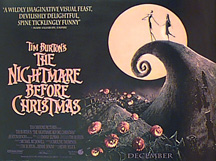 Directed
by: Henry Selick
Directed
by: Henry Selick
Written by: Tim Burton (poem) & Michael
McDowell
Music by: Danny
Elfman
Released on: October 29, 1993
Running Time: 76 minutes
Budget: $18 million
Box-Office: $51 million in the U.S., $
million worldwide
 Jack
Skellington... Chris Sarandon (acting), Danny Elfman (singing)
Jack
Skellington... Chris Sarandon (acting), Danny Elfman (singing)
Sally & Shock... Catherine O'Hara
Dr. Finklestein... William Hickey
Mayor... Glenn Shadix
Lock... Paul Reubens
Oogie Boogie... Ken Page
Santa... Ed Ivory
Big Witch... Susan McBride
Corpse Kid, Corpse Mom, Small Witch... Debi Durst
Harlequin Demon, Devil, Sax Player... Greg Proops
The Clown With The Tearaway Face... Danny Elfman
Narrator... Patrick Stewart
![]() Catherine O'Hara was in BeetleJuice (1988), Paul "Pee Wee" Rubens
in Batman Returns (1992), and Chris Sarandon in Fright Night
(1985)...
Catherine O'Hara was in BeetleJuice (1988), Paul "Pee Wee" Rubens
in Batman Returns (1992), and Chris Sarandon in Fright Night
(1985)...
![]()
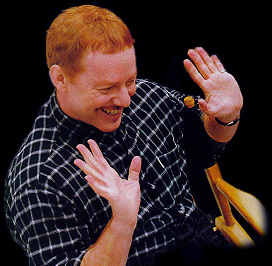 As
Danny Elfman (1953), the son of an Air Force father, was growing up in
the Los Angeles area, he was largely unaware of his talent for composing.
It wasn't until the early 1970's that Danny and his older brother Richard
started a musical troupe while in Paris; the group "Mystic Knights of Oingo-Boingo"
was created for Richard's directorial debut, The Forbidden Zone
(now considered a cult classic by Elfman fans). The group's name has gone
through many incarnations over the years, from "Mystic Knights" and "Oingo-Boingo"
to, eventually, its current name, "Boingo". While continuing to compose
eclectic, intelligent rock music for his L.A.-based band (some of which
had been used in various film soundtracks, e.g. "Weird Science" in a movie
by the same name), Danny formed a friendship with young director Tim Burton,
who was then a fan of Oingo-Boingo. Danny went on to score the soundtrack
of Pee-wee's Big Adventure (1985), which represented Danny's first
orchestral film score. The Elfman-Burton partnership continued (most notably
through the hugely-successful Batman flicks) and opened doors of
opportunity for Danny, who has been referred to as "Hollywood's hottest
film composer". Some of his best known scores include Scrooged
(1988), The Simpsons (1989), Dick Tracy (1990), Dolores
Claiborne (1995), Mission: Impossible (1996), Men In Black
(1997), Sleepy Hollow (1999) and Spider Man (2001).
Danny, who repeatedly admitted his all-time favorite character was Jack
Skellington, once stated: "...if there's one thing I really love... it's
sad music."
As
Danny Elfman (1953), the son of an Air Force father, was growing up in
the Los Angeles area, he was largely unaware of his talent for composing.
It wasn't until the early 1970's that Danny and his older brother Richard
started a musical troupe while in Paris; the group "Mystic Knights of Oingo-Boingo"
was created for Richard's directorial debut, The Forbidden Zone
(now considered a cult classic by Elfman fans). The group's name has gone
through many incarnations over the years, from "Mystic Knights" and "Oingo-Boingo"
to, eventually, its current name, "Boingo". While continuing to compose
eclectic, intelligent rock music for his L.A.-based band (some of which
had been used in various film soundtracks, e.g. "Weird Science" in a movie
by the same name), Danny formed a friendship with young director Tim Burton,
who was then a fan of Oingo-Boingo. Danny went on to score the soundtrack
of Pee-wee's Big Adventure (1985), which represented Danny's first
orchestral film score. The Elfman-Burton partnership continued (most notably
through the hugely-successful Batman flicks) and opened doors of
opportunity for Danny, who has been referred to as "Hollywood's hottest
film composer". Some of his best known scores include Scrooged
(1988), The Simpsons (1989), Dick Tracy (1990), Dolores
Claiborne (1995), Mission: Impossible (1996), Men In Black
(1997), Sleepy Hollow (1999) and Spider Man (2001).
Danny, who repeatedly admitted his all-time favorite character was Jack
Skellington, once stated: "...if there's one thing I really love... it's
sad music."
![]() In a 2001 interview, Danny Elfman further commented on his experience working
on this movie, and how he and Tim Burton didn't talk after it for a whole
year: "I spent 2.5 years on this picture. I was producing, voicing half
the characters, writting the songs and lyrics... I did my best not to sound
like Disney and stay away from the standards of that kind of movies which
I hate. Right after that project, I started working on Ed Wood.
That's when Tim and I had a big argument. Looking back at it now, I realized
that it was bound to happen: our relationship was too intense, too intimate,
and I invested so much in The Nightmare Before Christmas... It had
to explode! We swore we wouldn't talk to each over ever again. Tim and
I, we're a bit like dysfunctional brothers. I actually fought several times
with my own brother, swearing I wouldn't talk to him again. But it didn't
last. Eventually, you always come back to your family. That's what happened
with Tim. I met him one year later in a coffee shop in Kansas, where he
was shooting Mars Attacks! We realized how stupid we had been, and
we fell in each other's arms, and that was it! This huge relief is apparent
in the movie, in which the music is totally liberated, based only on humor
and craziness!"
In a 2001 interview, Danny Elfman further commented on his experience working
on this movie, and how he and Tim Burton didn't talk after it for a whole
year: "I spent 2.5 years on this picture. I was producing, voicing half
the characters, writting the songs and lyrics... I did my best not to sound
like Disney and stay away from the standards of that kind of movies which
I hate. Right after that project, I started working on Ed Wood.
That's when Tim and I had a big argument. Looking back at it now, I realized
that it was bound to happen: our relationship was too intense, too intimate,
and I invested so much in The Nightmare Before Christmas... It had
to explode! We swore we wouldn't talk to each over ever again. Tim and
I, we're a bit like dysfunctional brothers. I actually fought several times
with my own brother, swearing I wouldn't talk to him again. But it didn't
last. Eventually, you always come back to your family. That's what happened
with Tim. I met him one year later in a coffee shop in Kansas, where he
was shooting Mars Attacks! We realized how stupid we had been, and
we fell in each other's arms, and that was it! This huge relief is apparent
in the movie, in which the music is totally liberated, based only on humor
and craziness!"
![]() During the "This is Halloween" scene with Jack Skellington, one of the
ghosts is Donald Duck and you can even hear him make a quacking noise when
someone punches him.
During the "This is Halloween" scene with Jack Skellington, one of the
ghosts is Donald Duck and you can even hear him make a quacking noise when
someone punches him.
![]() Tim Burton was an animator at Disney in the early 1980s when he first dreamed
up Nightmare. The concept was shopped as a film, as a television
special, "I would have done it on the side of a building," Burton says.
But no one bit, and the project was quietly filed away. It was only years
later, after Burton struck it big directing Batman, that he had the clout
to make Nightmare. Disney still owned the rights but was happy to sign
the reigning king of dark fairy tales. Burton, a fan of the Rudolph the
Red-Nosed Reindeer 1960s Christmas special, wanted to use the same technique--stop-motion
animation--for Nightmare. Because the method was so time-intensive and
specialized, Burton handed over directing duties to animator Henry Selick.
Making Nightmare was a logistical nightmare. Each puppet had 25-30 sculpted
heads, one for each vowel and consonant. To keep the lips synched, a computer
was used to determine the head sequence. Then each frame was shot with
the set carefully lighted and puppets choreographed each time. The movie
took more than three years to make. But as Disney prepared to release Nightmare,
Burton noted a lack of enthusiasm on the part of the marketing department.
"They were initially supportive, and I'm grateful for that," he says. "But
at the end of the day, they're always a little afraid. Walt was probably
spinning in his grave with this film. I was disappointed. It was the height
of political correctness, and it was seen as not for kids. Did they forget
what it was like to be a kid?"
Tim Burton was an animator at Disney in the early 1980s when he first dreamed
up Nightmare. The concept was shopped as a film, as a television
special, "I would have done it on the side of a building," Burton says.
But no one bit, and the project was quietly filed away. It was only years
later, after Burton struck it big directing Batman, that he had the clout
to make Nightmare. Disney still owned the rights but was happy to sign
the reigning king of dark fairy tales. Burton, a fan of the Rudolph the
Red-Nosed Reindeer 1960s Christmas special, wanted to use the same technique--stop-motion
animation--for Nightmare. Because the method was so time-intensive and
specialized, Burton handed over directing duties to animator Henry Selick.
Making Nightmare was a logistical nightmare. Each puppet had 25-30 sculpted
heads, one for each vowel and consonant. To keep the lips synched, a computer
was used to determine the head sequence. Then each frame was shot with
the set carefully lighted and puppets choreographed each time. The movie
took more than three years to make. But as Disney prepared to release Nightmare,
Burton noted a lack of enthusiasm on the part of the marketing department.
"They were initially supportive, and I'm grateful for that," he says. "But
at the end of the day, they're always a little afraid. Walt was probably
spinning in his grave with this film. I was disappointed. It was the height
of political correctness, and it was seen as not for kids. Did they forget
what it was like to be a kid?"
![]() In the German version, Sally was voiced over by singer Nina Hagen.
In the German version, Sally was voiced over by singer Nina Hagen.
![]() In the song, "This is Halloween," the lyrics "...tender lumplings everywhere..."
refers to "Tender Lumplings," a song done by composer Danny Elfman when
he was with Oingo Boingo.
In the song, "This is Halloween," the lyrics "...tender lumplings everywhere..."
refers to "Tender Lumplings," a song done by composer Danny Elfman when
he was with Oingo Boingo.
![]() Tim Burton’s companion Lisa Marie was the inspiration for the character
of Sally.
Tim Burton’s companion Lisa Marie was the inspiration for the character
of Sally.
![]() Looking back at the project in October 2002, director Henry Selick commented:
"Making Nightmare Before Christmas was the smoothest filmmaking
experience I’ve ever had. I'll probably never have another filmmaking experience
like it in my career," says director . "To have Tim as your godfather on
a project like that is a real gift. It was very labor intensive, of course--at
the height of production we only produced 70 seconds of finished film per
week--but every day we saw miracles and it was very rewarding. Nightmare
was truly a hand-made movie: Every frame was crafted by an artist. Tim
and I never disagreed except once. I proposed a completely different ending
to what Tim wanted. I sprung it on him--a big surprise--all storyboarded,
temp voices and music and everything and I thought I was going to hit it
out of the park. He looked at it, his jaw dropped and he walked outside
and kicked a hole in the wall."
Looking back at the project in October 2002, director Henry Selick commented:
"Making Nightmare Before Christmas was the smoothest filmmaking
experience I’ve ever had. I'll probably never have another filmmaking experience
like it in my career," says director . "To have Tim as your godfather on
a project like that is a real gift. It was very labor intensive, of course--at
the height of production we only produced 70 seconds of finished film per
week--but every day we saw miracles and it was very rewarding. Nightmare
was truly a hand-made movie: Every frame was crafted by an artist. Tim
and I never disagreed except once. I proposed a completely different ending
to what Tim wanted. I sprung it on him--a big surprise--all storyboarded,
temp voices and music and everything and I thought I was going to hit it
out of the park. He looked at it, his jaw dropped and he walked outside
and kicked a hole in the wall."
![]() Henry Selick further commented that "it’s a full-blown musical. Most of
the movies at the time had maybe four or five songs max and this one has
10 songs. I think it’s close to an operetta. So I guess musically speaking,
it was aimed at an older audience. There was only one thing in the entire
film that Disney asked me not to do. It was the clown with the tear-away
face. The first design, when he tore his face away, was bloody and awful.
I didn’t have a problem changing it because it never quite felt right.
And there were other things, like where Sally gets her arm pulled off.
I stuffed leaves in there where some of the guys working on it wanted to
make her like Frankenstein, made of real body parts. A big thing was the
ending of the movie. I spent a long time planning the battle between Oogie
Boogie and Jack. The point where Oogie Boogie gets skinned alive and there’s
all these bugs, that wasn’t seen [by Burton] until it was finished and
it was too late to change it. That was the biggest risk in the movie--whether
we’d gone too far or not."
Henry Selick further commented that "it’s a full-blown musical. Most of
the movies at the time had maybe four or five songs max and this one has
10 songs. I think it’s close to an operetta. So I guess musically speaking,
it was aimed at an older audience. There was only one thing in the entire
film that Disney asked me not to do. It was the clown with the tear-away
face. The first design, when he tore his face away, was bloody and awful.
I didn’t have a problem changing it because it never quite felt right.
And there were other things, like where Sally gets her arm pulled off.
I stuffed leaves in there where some of the guys working on it wanted to
make her like Frankenstein, made of real body parts. A big thing was the
ending of the movie. I spent a long time planning the battle between Oogie
Boogie and Jack. The point where Oogie Boogie gets skinned alive and there’s
all these bugs, that wasn’t seen [by Burton] until it was finished and
it was too late to change it. That was the biggest risk in the movie--whether
we’d gone too far or not."
![]() Glenn Shadix, who provides the voice of the Mayor of Halloween Town, commented:
"This is one project I felt was a classic the first time I saw a rough
cut. Tim created the world and Henry brought it to life. I got involved
when I was in Tim's pool and he was in the Jacuzzi nearby one Sunday in
the summer of 1991. He yelled down to me, 'Hey Glenn, you got a big voice.
Wanna do the Mayor in Nightmare?' I wasted no time yelling back 'Sure!'
And that was that."
Glenn Shadix, who provides the voice of the Mayor of Halloween Town, commented:
"This is one project I felt was a classic the first time I saw a rough
cut. Tim created the world and Henry brought it to life. I got involved
when I was in Tim's pool and he was in the Jacuzzi nearby one Sunday in
the summer of 1991. He yelled down to me, 'Hey Glenn, you got a big voice.
Wanna do the Mayor in Nightmare?' I wasted no time yelling back 'Sure!'
And that was that."
![]() In late March 2000, Tim Burton had a series of meetings with Disney producers,
rumoured to be about a possible sequel to The Nightmare Before Christmas.
These apparently were actually to prepare for a re-release of the movie
and a Halloween special at the Disney parks.
In late March 2000, Tim Burton had a series of meetings with Disney producers,
rumoured to be about a possible sequel to The Nightmare Before Christmas.
These apparently were actually to prepare for a re-release of the movie
and a Halloween special at the Disney parks.
![]() "[The Nightmare Before Christmas] is 99.9% handmade," director Henri
Selick explained in November 2002. "If I were making it again, even with
all the advances in CG, I would definitely go stop motion. The built-in
flaws give it a charm and there’s a tactile quality. I think there will
always be some stop motion films, but it’s not like everyone’s going to
get involved. It’s too difficult. It takes too long. I’m a little disappointed
with Aardman taking so long to get their next feature up and running after
Chicken
Run. I think they’re going through the Jeffrey Katzenberg story
development hell. He’s going to make sure it’s absolutely perfect, work
it to death. This past spring, for a few days, I was talking with Disney
about a sequel [to Nightmare Before Christmas]. We got down the road a
little bit. I was disappointed that even Disney wanted to do it CG and
that didn’t feel right to me. I think probably they thought of it as a
way to modernize it, to make it sexy and new. A big mistake. [A sequel]
will really be up to Tim Burton, if he’s in the mood."
"[The Nightmare Before Christmas] is 99.9% handmade," director Henri
Selick explained in November 2002. "If I were making it again, even with
all the advances in CG, I would definitely go stop motion. The built-in
flaws give it a charm and there’s a tactile quality. I think there will
always be some stop motion films, but it’s not like everyone’s going to
get involved. It’s too difficult. It takes too long. I’m a little disappointed
with Aardman taking so long to get their next feature up and running after
Chicken
Run. I think they’re going through the Jeffrey Katzenberg story
development hell. He’s going to make sure it’s absolutely perfect, work
it to death. This past spring, for a few days, I was talking with Disney
about a sequel [to Nightmare Before Christmas]. We got down the road a
little bit. I was disappointed that even Disney wanted to do it CG and
that didn’t feel right to me. I think probably they thought of it as a
way to modernize it, to make it sexy and new. A big mistake. [A sequel]
will really be up to Tim Burton, if he’s in the mood."
THE ORIGINS OF THE NIGHTMARE BEFORE CHRISTMAS
Excerpt from Burton on Burton, edited by Mark Salisbury
After completing Vincent in 1982, Tim Burton had begun work on
another project based on a poem he had written, this
time inspired by Clement Clarke Moore's The Night Before Christmas.
His initial impulse for doing it was the love of Dr Seuss, and the stop-motion
animation holiday specials he grew up watching: Tim Burton conceived The
Nightmare Before Christmas as an expanded version of Vincent,
and wrote the poem with Vincent Price in mind as the narrator.
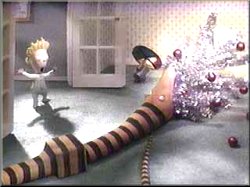
"Back then I think I would have done it as anything - a television
special, a short film - whatever would have gotten it done at the time.
It was a funny project because everybody was really nice about it, but
it was like being in that show The Prisoner; everybody's really
nice, but you know you're never going to get out, it's not going to happen.
I took it around the networks, did storyboards and sketches and Rick Heinrichs
did a little model of Jack. Everybody said they liked it, but not enough
to do it at that time. I guess that was my first real taste of that kind
of showbusiness mentality - a nice big smile and an 'Oh yeah, we're going
to do this'. But, as you proceed, it becomes less and less of a reality.
It was after Vincent, so I was really into stop-motion. I think it's harder to do emotional stuff in three dimensions. In so many ways drawn animation is easier because you can truly do anything, you can draw anything. Three-dimensional animation has limitations because you're moving puppets around. But I think when it works it is more effective because it is three-dimensional, and it feels like it's there.
The characters that were designed for Nightmare had the added burden of not having any eyeballs. The first rule of animation is: Eyes for Expression. But a lot of the characters either don't have any eyes, or their eyes are sewn shut. I thought if we could give life to these characters that have no eyes, it would be great. So, after drawing all those foxes with their wet drippy eyes at Disney, there was a little subversion in having these characters with no eyes. It was funny to think of a character that had these big black holes and to try and make that work.
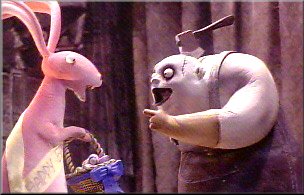 The
idea behind Nightmare also came from a combination of feelings to do with
love for those Rudolph things. Thematically that's something that I like,
still respond to, and have responded to in other films about that type
of character, somebody, like a Grinch, who is perceived as scary but isn't.
Again, that goes back to the monster movies I liked as a kid. They were
perceived as frightening and bad, but they're weren't. It's also true in
society; people get perceived that way all the time. I felt that way and
I never liked it, therefore I always liked characters who were passionate
and felt certain ways, but weren't what they were perceived to be.
The
idea behind Nightmare also came from a combination of feelings to do with
love for those Rudolph things. Thematically that's something that I like,
still respond to, and have responded to in other films about that type
of character, somebody, like a Grinch, who is perceived as scary but isn't.
Again, that goes back to the monster movies I liked as a kid. They were
perceived as frightening and bad, but they're weren't. It's also true in
society; people get perceived that way all the time. I felt that way and
I never liked it, therefore I always liked characters who were passionate
and felt certain ways, but weren't what they were perceived to be.
When I developed it originally, it was during the period when Disney was actually changing over, and when I didn't know if I was still an employee or not. I was just hanging around. I always felt that it was one project that I would like to make, I felt so secure about it. There was talk of doing it as a kind of TV special, or doing it drawn. But I just didn't want to do any of that. So, I decided to bury it, but always with that feeling that I would do it some time. It was weird, some projects you feel more like, 'Oh, I'd better do this now or never', but I never felt that way about Nightmare."
[Over the years Burton's thoughts regularly returned to the project and in 1990 he had his agent check to see whether Disney still owned the rights to Nightmare with a view to resurrecting it.]
I didn't even know if they owned it. So we tried to quietly say, 'Can we look around your basement?' And they did own it, because they own everything. There's this thing you sign when you work there, which states that any thoughts you have during your employment are owned by the thought police. Obviously, there's no real way of doing it quietly. We tried, but they were soon right there and they were fine - which is against their nature - so I'm very respectful and feel honoured that they let it happen. This was after Edward Scissorhands and Batman, and the reason it got made is because I've been lucky enough to be successful. That's really the only reason it got made. It certainly wasn't a case of the time being right. But I will say this about Disney, they at least understood our trying to push the envelope a little bit as far as the animation was concerned, they were responsive to that.
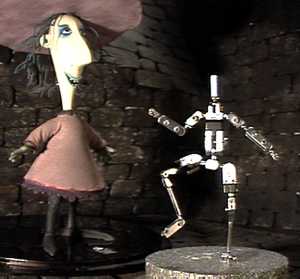 It's
a funky old art form stop-motion, and even though new technology was used
at times in Nightmare, basically it's artists doing it and painting sets
and making things. There's something very gratifying about that, something
I love and never want to forget. It's the handmade aspect of things, part
of an energy that you can't explain. You can sense it when you see the
concentration of the animators as they move the figures, there's an energy
that's captured. It's like when you look at a Van Gogh painting. I remember
the first time I saw one in reality. You've seen them in books, but the
energy that's captured on the canvas is incredible, and I think that's
something that nobody talks about because it's not something literal.
It's
a funky old art form stop-motion, and even though new technology was used
at times in Nightmare, basically it's artists doing it and painting sets
and making things. There's something very gratifying about that, something
I love and never want to forget. It's the handmade aspect of things, part
of an energy that you can't explain. You can sense it when you see the
concentration of the animators as they move the figures, there's an energy
that's captured. It's like when you look at a Van Gogh painting. I remember
the first time I saw one in reality. You've seen them in books, but the
energy that's captured on the canvas is incredible, and I think that's
something that nobody talks about because it's not something literal.
It's the same with this kind of animation, and I think that's the power of Ray Harryhausen. When it's done beautifully, you feel somebody's energy. It's something that computers will never be able to replace, because they're missing that one element. For as good as computers are and as incredible as it will get and is right now, it goes back to painters and their canvases. This project and these characters and these visuals, the only way that it could have been done was with stop-motion. Therefore, it's very specialized. I remember getting shots and each time I would see a shot I would get this little rush of energy; it was so beautiful. It's like a drug. And I realized if you did it in live-action it wouldn't be as good; if you did it in drawing it wouldn't be as good. There is something about stop-motion that gives it an energy that you don't get in any other form."
Tim Burton wanted to make the movie ever since he worked as an animator at the Walt Disney Studios in the early eighties. He designed all the characters 10 years before the movie was made. He first wanted to make a holiday special for TV out of it, then a children's book.
When the project finally got the green light from Disney, Tim Burton decided against directing it himself, as he felt only a master of stop-motion animation could properly bring the story to life: "The Nightmare Before Christmas is deeper in my heart than any other film. It is more beautiful than I imagined it would be. As I watch it, I know I will never have this feeling again."
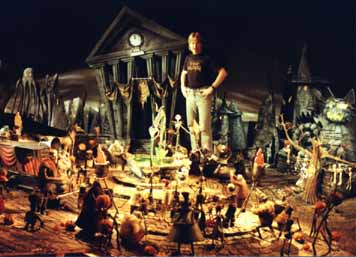 [Despite
Nightmare's
proximity to his heart, Burton passed on directing the project because
of his commitment to Batman Returns and the painstakingly slow production
period necessary to complete a project of this kind. Instead, he chose
Henry Selick, whom he had first met at Disney in the late seventies and
to whom he had shown his original Nightmare sketches in 1982. Since the
early eighties, Selick had been living and working in San Francisco, an
area that had become the centre for stop-motion animators. It was here
that Disney's adult-orientated arm Touchstone Pictures and Burton set up
Skellington Productions, and began work on Nightmare in July 1991.]
[Despite
Nightmare's
proximity to his heart, Burton passed on directing the project because
of his commitment to Batman Returns and the painstakingly slow production
period necessary to complete a project of this kind. Instead, he chose
Henry Selick, whom he had first met at Disney in the late seventies and
to whom he had shown his original Nightmare sketches in 1982. Since the
early eighties, Selick had been living and working in San Francisco, an
area that had become the centre for stop-motion animators. It was here
that Disney's adult-orientated arm Touchstone Pictures and Burton set up
Skellington Productions, and began work on Nightmare in July 1991.]
"Henry is a real artist. He's truly the best. He had done a lot of great stuff for MTV and was doing a lot of great stuff for stop-motion animation. There was a whole group of really talented artists up there in San Francisco. It's just that, even more than with drawn animation, it's hard to find people who are really talented at it, because it's a much more rarified form, and such an intense process. So, they let us do it up in San Francisco.
When I wasn't shooting I would go up there because I loved it, but most of the time Henry would just send me stuff -there'd be a few shots during the week - and so over the period of a couple of years it all came together. I would get a reel and I had an editing room and I would edit some shots when I was working on the second Batman movie. At that stage, there's something about it taking so long that means you can just sit there and enjoy it, and look at the texture.
It was the hardest thing I ever worked on, in a way, because it just
took so long, and there were a lot of people involved, a lot of artists.
Hopefully, most people you work with are artists, but it's an intense thing,
stop-motion animation, and the thing that I was looking for all the time
was just the feeling of it. Everybody contributed something, everybody
had ideas and stuff, but what I always tried to do was just go back to
that initial feeling. And even though it expanded, I would try to keep
it on a certain track. It's funny, because when a project takes that much
time, and I've been in animation so I know, ideas come all the time. That's
fine, but sometimes the ideas are scary because people want to change this
and change that. That's just the nature of it, because the ideas are quicker
than the process. So, I tried to keep a constant watch. Actually, I enjoyed
working in this way because the project took three
years, and even if I was working on other things I could make a sketch
or comment on things. And as the shots got assembled, I just tried to run
it through that original feeling.
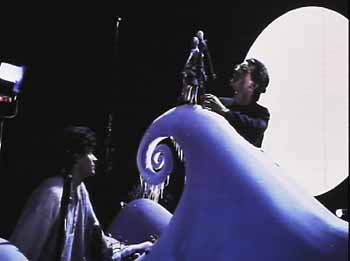 I
guess my main concern, was that Henry, being an artist in his own right,
wouldn't do the things I wanted. I was worried about that kind of tension.
But it wasn't like that. He was great. That's why it's important very early
on for people to be in synch about a project. So those early meetings are
almost the most important. It's like, if you were doing a book, you would
try to be faithful to the material. I wanted to feel comfortable that Henry
was into that, otherwise you'd be fighting all time, and that couldn't
happen. I've known some people who like to fight, who like that kind of
struggle on set. I don't really like that. I don't like working with actors
who aren't into it. You want people that are one hundred per cent into
a project, even if they don't completely get it. So, there was no better
group of people to do that movie and I always felt it was a special time.
The studio was incredible and I just loved going up there because that
level of artistry and detail was magical, truly magical and I'd never really
felt that before.
I
guess my main concern, was that Henry, being an artist in his own right,
wouldn't do the things I wanted. I was worried about that kind of tension.
But it wasn't like that. He was great. That's why it's important very early
on for people to be in synch about a project. So those early meetings are
almost the most important. It's like, if you were doing a book, you would
try to be faithful to the material. I wanted to feel comfortable that Henry
was into that, otherwise you'd be fighting all time, and that couldn't
happen. I've known some people who like to fight, who like that kind of
struggle on set. I don't really like that. I don't like working with actors
who aren't into it. You want people that are one hundred per cent into
a project, even if they don't completely get it. So, there was no better
group of people to do that movie and I always felt it was a special time.
The studio was incredible and I just loved going up there because that
level of artistry and detail was magical, truly magical and I'd never really
felt that before.
[To adapt his original, three-page poem into a feature-length script, Burton originally called upon Beetlejuice writer Michael McDowell. But when the collaboration didn't pan out quite the way Burton planned, he decided to attack the project from a musical standpoint and turned to his regular partner Danny Elfman. Together, Burton and Elfman, who also provides the singing voice of Jack in the movie, fleshed out a rough storyline and two-thirds of the film's songs, which Selick and his team of animators began work on even before Caroline Thompson was brought in to incorporate them into a screenplay.]
"What Danny and I had when we started was the poem that I wrote and
some drawings and some storyboards, and also this story outline I did about
ten years ago. I would go over to his house and we would just treat it
like an operetta, not like the musicals that they did, but more like that
old-fashioned kind of thing, where the songs are more engrained in the
story. I would begin to tell him the story and he'd write a song; he wrote
them pretty quickly, actually, at least the initial pass on them. We worked
in a weird way, where there was the outline and the songs and then we worked
out the script. There was a lot going on, that was what was so diffIcult
about it. They were doing the storyboards up there, we were doing the script,
all this stuff was happening at once. It's not the best way to do
it, but this was a new thing we were trying to do.
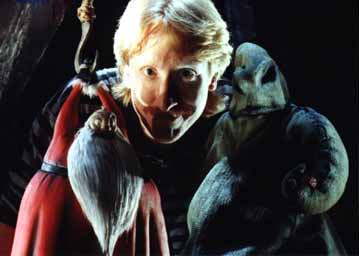 So,
Danny and I would go through my little outline and I'd say Jack does this
and then he does that and then he falls into Christmastown. We'd worked
together so much that it didn't matter that we didn't know what we were
doing; at least we knew each other. So we just took at stab at it. And
again, since we had worked together before, he worked very quickly, which
was good because we needed the songs so we could do the script. He wrote
them fairly quickly, within a couple of months; he would play me stuff
the next week, sometimes the next day. Then I brought in Caroline and she
knew Danny. It was a gradual, evolving process: there's Henry, there's
me, there's Danny, there's Caroline, and that's a lot to deal with. And
then you add in the other incredible artists.
So,
Danny and I would go through my little outline and I'd say Jack does this
and then he does that and then he falls into Christmastown. We'd worked
together so much that it didn't matter that we didn't know what we were
doing; at least we knew each other. So we just took at stab at it. And
again, since we had worked together before, he worked very quickly, which
was good because we needed the songs so we could do the script. He wrote
them fairly quickly, within a couple of months; he would play me stuff
the next week, sometimes the next day. Then I brought in Caroline and she
knew Danny. It was a gradual, evolving process: there's Henry, there's
me, there's Danny, there's Caroline, and that's a lot to deal with. And
then you add in the other incredible artists.
I remember drawing Jack and really getting into these black holes for eyes and thinking that to be expressive, but not have ally eyes, would be really incredible. Sally was a relatively new character; I was into stitching from the Catwoman thing, I was into that whole psychological thing of being pieced together. Again, these are all symbols for the way that you feel. The feeling of not being together and of being loosely stitched together and constantly trying to pull yourself together, so to speak, is just a strong feeling to me. So those kind of visual symbols have less to do with being based on Frankenstein, than with the feeling of pulling yourself together.
To me, Halloween has always been the most fun night of the year. It's where rules are dropped and you can be anything at all. Fantasy rules. It's only scary in a funny way. Nobody's out to really scare anybody else to death. They're out to delight people with their scariness, which is what Halloween is all about and what Nightmare is all about.
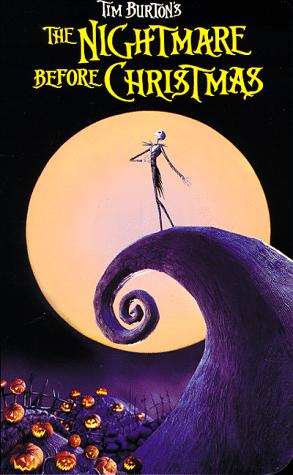 At
its release, the movie was considered too scary for kids. "Which
was great, which was interesting, because it's what the story is about.
Here you have this story where there are no really bad characters, not
even Oogie Boogie; he's not really bad, he's just the weird neighbour in
this weird city. And you have this character, Jack, who just wants to do
good; he's passionate about something, and basically he ends up being misperceived
and scaring everybody. It's funny, it took on the life of what it was about
in real life. It was like, 'Wait a minute. This is exactly what the movie
is about. People are freaking out because they think it's scary, but it's
not. There really isn't anything in it.' Kids are incredible. If you show
it to a bunch of kids without their parents it's great, but as soon as
you get the parents involved, you get: 'This is too scary.' I've seen this
happen before and it's a very disturbing phenomenon. If something was too
scary for me, I wouldn't watch it, I was never forced to, but when you
get a parent giving you this weird vibe, it puts you on edge."
At
its release, the movie was considered too scary for kids. "Which
was great, which was interesting, because it's what the story is about.
Here you have this story where there are no really bad characters, not
even Oogie Boogie; he's not really bad, he's just the weird neighbour in
this weird city. And you have this character, Jack, who just wants to do
good; he's passionate about something, and basically he ends up being misperceived
and scaring everybody. It's funny, it took on the life of what it was about
in real life. It was like, 'Wait a minute. This is exactly what the movie
is about. People are freaking out because they think it's scary, but it's
not. There really isn't anything in it.' Kids are incredible. If you show
it to a bunch of kids without their parents it's great, but as soon as
you get the parents involved, you get: 'This is too scary.' I've seen this
happen before and it's a very disturbing phenomenon. If something was too
scary for me, I wouldn't watch it, I was never forced to, but when you
get a parent giving you this weird vibe, it puts you on edge."
Sometimes I'll see people wearing the Nightmare Burger King watch in
the weirdest places. I just saw somebody wearing it who worked at Carnegie
Hall, and it's incredible. People will come up and they'll have a little
picture of Jack with them. It's funny because sometimes when things connect
with people, maybe not a large group, but with some, it's really wonderful
to me. A lot of people and critics don't get that there is an emotion underneath
these weird, stupid-looking things. Some people do, and that probably means
the most to me: that people get the emotional quality underneath the stupid
facade."
Q: For someone with your preoccupations, how did you begin your career as a Disney animator?
Tim Burton: (laughing) That’s exactly the question that struck me by the end of my first month! And it struck them, too, I’m sure. I don’t know, it seemed like the right thing for an art student like me. It was a really weird experience. It was a moment of transition in the company’s life, when they didn’t know where they where heading. I was an art student from Cal Arts, and Disney was recruiting masses, kind of like ‘I want you to join the US Army’. For me, that meant Disney was a creative place, open to new ideas. The idea was that we were there to create new stuff, but the studio people went nuts with all the things we proposed. We felt like characters in that TV series, The Prisoner – everyone was very smiley at Disney, but everyone was very anxious at the same time. There were people that were very creative and passionate about the job, but the job itself was... weird. Any project that was really new and different was shelved right away. It was impossible to make something like this movie [‘The Nightmare Before Christmas’]. That’s why I left Disney.
Q: What were the main divergences between you and Disney?
Tim Burton: Oh, everything. It
was a radical difference of points of view, style, and even lines. My lines
are pointy, rough, Disney likes round, soft eyes. What about eyes? I draw
everyone without eyes, and Disney loves big eyes...
Q: Your education, then, is not filmmaking, but arts...
Tim Burton: I’ve never been a film student. I grew up watching horror films and cartoons and Dr. Seuss stories on TV, and all those things have certainly influenced me. But I didn’t have the traditional filmmaking education. I ended up making films as a progression of my work in arts, because I wanted to blend motion to 3D. That’s why my first experiences in film where in stop-motion.
Q: You returned to this technique in 93, with The Nightmare Before Christmas, a film you produced and your friend and Cal Arts and Disney mate, Henry Selick, directed. Why?
Tim Burton: I’ve always imagined this film in 3D, hence stop-motion. It’s a painstaking, manual, process. And, in fact, stop-motion animation itself is more rustic, but it also has an element of grace and elegance that’s only possible through stop-motion. Besides, another kind of film that influenced me were the fantasy films of Ray Harryhausen, like ‘Jason and the Argonauts’, with monsters animated in stop-motion. I though those monsters were the greatest.
Q: ‘Nightmare...’, as a matter of fact, marked your return to Disney, but it didn’t sound at all like a typical film from that studio. How was that possible?
Tim Burton: Well, the project was
a sort of parallel Disney. But, deep, deep inside, the differences were
only in looks – all the characters in this movie are essentially good.
There are no villains, just a bunch of weird looking people. Maybe, in
looks, the characters from Halloween Town are scary, but, deep inside they’re
good, honest, hard-working people, who get carried away by the idea of
making something new, different, fun. Even the idea of taking over Christmas
isn’t malicious – they just want to give Santa Claus a rest, to do something
different. I believe that, if superficially ‘Nightmare’ looked different,
in its heart it did bear resemblance to Disney’s films. Today the studio’s
situation is quite different. It’s a new administration. We had absolute
freedom to carry on the project.
November 2002 Interview Conducted by Animation Magazine Online
Q: When you set out to make a holiday film, it’s assumed that the aim is to create a classic that will stand the test of time. Do you think that 20 years from now audiences will still respond to it the way they do the Rankin and Bass films?
Henry Selick: I don’t know if they’ll respond the same way. Clearly the Rankin and Bass films have held up for a very long time. It’s nine years and counting for Nightmare, so I believe that there will still be a very strong response 20 years from now or 50 years from now. We were never thinking of it as a classic. It just seems to have happened accidentally.
Q: It seems like it’s become more of a favorite among adults than children. Is it aimed more at an adult audience?
Henry Selick: It was really never aimed at anyone. It’s a full-blown musical. Most of the movies at the time had maybe four or five songs max and this one has 10 songs. I think it’s close to an operetta. So I guess musically speaking, it was aimed at an older audience. Disney released it as a Touchstone picture. They didn’t put the Disney name on it. So I don’t think they ever thought of it as a kids’ film. But right from the get-go, very young kids, as young as three years old, liked it and were not afraid of it.
Q: It’s certainly not Rudolph The Red-nosed Reindeer. Was the darker tone and the scariness of it a concern at all?
Henry Selick: There was very little that we changed. There was only one thing in the entire film that Disney asked me not to do. It was the clown with the tear-away face. The first design, when he tore his face away, was bloody and awful. I didn’t have a problem changing it because it never quite felt right. And there were other things, like where Sally gets her arm pulled off. I stuffed leaves in there where some of the guys working on it wanted to make her like Frankenstein, made of real body parts. A big thing was the ending of the movie. I spent a long time planning the battle between Oogie Boogie and Jack. The point where Oogie Boogie gets skinned alive and there’s all these bugs, that wasn’t seen [by Burton] until it was finished and it was too late to change it. That was the biggest risk in the movie — whether we’d gone too far or not.
Q: Any digital technology used?
Henry Selick: We used computers to plan camera moves and clean up mistakes that were made — light pops and things like that. The only real CG in it is at the very end where the snow is falling. The movie is 99.9% handmade.
Q: If it were made today, do you think it would be made with CG or is there something about it that begs to have the look and feel of stop motion?
Henry Selick: I think most people would make the mistake of assuming it should be CG. But if I were making it again, even with all the advances in CG, I would definitely go stop motion. The built-in flaws give it a charm and there’s a tactile quality. You know that what you’re seeing really existed in some form or another. For the right story, stop motion is still appropriate.
Q: How do you perceive the future of stop motion?
Henry Selick: Right now all the smart money’s on CG because that’s where all the biggest successes have been. So it’s about what’s in fashion and where people want to risk their money. I think there will always be some stop motion films, but it’s not like everyone’s going to get involved. It’s too difficult. It takes too long. I’m a little disappointed with Aardman taking so long to get their next feature up and running after Chicken Run. I think they’re going through the Jeffrey Katzenberg story development hell. He’s going to make sure it’s absolutely perfect, work it to death.
Q: For viewers who haven’t seen Nightmare on the big screen for a while or have never seen it at all, is there anything we should look for?
Henry Selick: If you really know it, it’s not like you have to follow the lead characters. I would make a practice to avoid looking at the key elements in a scene because there’s always something amazing going on in the background. There are layers and layers of beautiful things in the film. If you think you’ve seen the movie a lot, you’ll want to watch it again. Don’t just look at Jack and Sally. Look at what’s happening around them.
Q: Can we ever look forward to a sequel?
Henry Selick: Hard to know. This past spring, for a few days, I was talking with Disney about a sequel. We got down the road a little bit. I was disappointed that even Disney wanted to do it CG and that didn’t feel right to me.
Q: Why do they want CG?
Henry Selick: I think probably they thought of it as a way to modernize it, to make it sexy and new. A big mistake. [A sequel] will really be up to Tim Burton, if he’s in the mood.
Q: I’ve heard a rumor that he has a stop motion feature in the works, something called Corpse Bride.
Henry Selick: Yeah, it’s an old
Eastern European folktale. The Corpse Bride has been performed in plays
and is in a lot of storybooks. It’s something he’s been working on for
six years. I was involved for a little while, trying to figure out a story
about four years ago. But I guess he’s going to go forward and do it in
England. There’s a lot of good stop motion people there.
THE ORIGINAL THE NIGHTMARE BEFORE CHRISTMAS POEM
Text and Illustrations by Tim Burton
 It
was late one fall in Halloweenland, and the air had quite a chill.
It
was late one fall in Halloweenland, and the air had quite a chill.
Against the moon a skeleton sat, alone upon a hill.
He was tall and thin with a bat bow tie;
Jack Skellington was his name.
He was tired and bored in Halloweenland--
Everything was always the same.
 "I'm
sick of the scaring, the terror, the fright.
"I'm
sick of the scaring, the terror, the fright.
I'm tired of being something that goes bump in the night.
I'm bored with leering my horrible glances,
And my feet hurt from dancing those skeleton dances."
I don't like graveyards, and I need something new.
There must be more to life than just yelling, 'Boo!'"
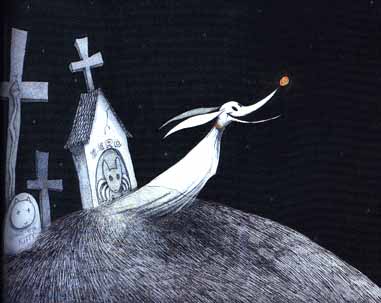 Then
out from a grave, with a curl and a twist,
Then
out from a grave, with a curl and a twist,
Came a whimpering, whining, spectral mist.
It was a little ghost dog, with a faint little bark,
And a jack-o'-lantern nose that glowed in the dark.
It was Jack's dog, Zero, the best friend he had,
But Jack hardly noticed, which made Zero sad.
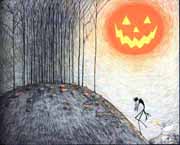 All
that night and through the next day,
All
that night and through the next day,
Jack wandered and walked. He was filled with dismay.
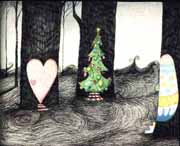 Then
deep in the forest, just before night,
Then
deep in the forest, just before night,
Jack came upon an amazing sight.
Not twenty feet from the spot where he stood
Were three massive doorways carved in wood.
He stood before them, completely in awe,
His gaze transfixed by one special door.
Entranced and excited, with a slight sense of worry,
Jack opened the door to a white, windy flurry.
 Jack
didn't know it, but he'd fallen down
Jack
didn't know it, but he'd fallen down
In the middle of a place called Christmas Town!
Immersed in the light, Jack was no longer haunted.
He had finally found the feeling he wanted.
And so that his friends wouldn't think him a liar,
He took the present-filled stockings that hung by the fire.
He took candy and toys that were stacked on the shelves
And a picture of Santa with all of his elves.
He took lights and ornaments and the star from the tree,
And from the Christmas Town sign, he took the big letter C.
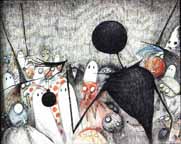 He
picked up everything that sparkled or glowed.
He
picked up everything that sparkled or glowed.
He even picked up a handful of snow.
He grabbed it all, and without being seen,
He took it all back to Halloween.
Back in Halloween a group of Jack's peers
Stared in amazement at his Christmas souvenires.
For this wondrous vision none were prepared.
Most were excited, though a few were quite scared!
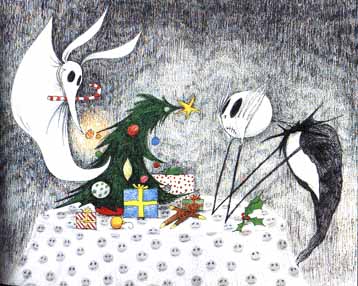 For
the next few days, while it lightninged and thundered,
For
the next few days, while it lightninged and thundered,
Jack sat alone and obsessively wondered.
"Why is it they get to spread laughter and cheer
While we stalk the graveyards, spreading panic and fear?
Well, I could be Santa, and I could spread cheer!
Why does he get to do it year after year?"
Outraged by injustice, Jack thought and he thought.
Then he got an idea. "Yes. . .yes. . .why not!"
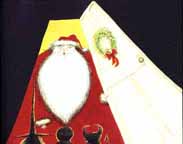 In
Christmas Town, Santa was making some toys
In
Christmas Town, Santa was making some toys
When through the din he heard a soft noise.
He answered the door, and to his surprise,
He saw weird little creatures in strange disguise.
They were altogether ugly and rather petite.
As they opened their sacks, they yelled, "Trick or treat!"
Then a confused Santa was shoved into a sack
And taken to Halloween to see mastermind Jack.
In Halloween everyone gathered once more,
For they'd never seen a Santa before
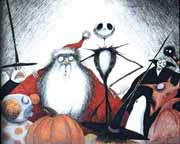 And
as they cautiously gazed at this strange old man,
And
as they cautiously gazed at this strange old man,
Jack related to Santa his masterful plan:
"My dear Mr. Claus, I think it's a crime
That you've got to be Santa all of the time!
But now I will give presents, and I will spread cheer.
We're changing places--I'm Santa this year.
It is I who will say Merry Christmas to you!
So you may lie in my coffin, creak doors, and yell, 'Boo!'
And please, Mr. Claus, don't think ill of my plan.
For I'll do the best Santa job that I can."
 And
though Jack and his friends thought they'd do a good job,
And
though Jack and his friends thought they'd do a good job,
Their idea of Christmas was still quite macabre.
They were packed up and ready on Christmas Eve day
When Jack hitched his reindeer to his sleek coffin sleigh,
But on Christmas Eve as they were about to begin,
A Halloween fog slowly rolled in.
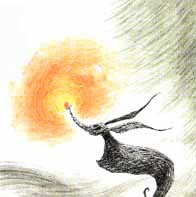 Jack
said, "We can't leave; this fog's just too think.
Jack
said, "We can't leave; this fog's just too think.
There will be no Christmas, and I can't be St. Nick."
Then a small glowing light pierced through the fog.
What could it be?. . .It was Zero, Jack's dog!
Jack said, "Zero, with your nose so bright,
Won't you guide my sleigh tonight?"
And to be so needed was Zero's great dream,
So he joyously flew to the head of the team.
And as the skeletal sleigh started its ghostly flight,
Jack cackled, "Merry Christmas to all, and to all a good night!"
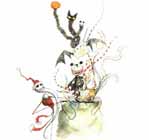 'Twas
the nightmare before Christmas, and all though the house,
'Twas
the nightmare before Christmas, and all though the house,
Not a creature was peaceful, not even a mouse.
The stockings all hung by the chimney with care,
When opened that morning would cause quite a scare!
The children, all nestled so snug in their beds,
Would have nightmares of monsters and skeleton heads.
The moon that hung over the new-fallen snow
Cast an eerie pall over the city below,
And Santa Claus's laughter now sounded like groans,
And the jingling bells like chattering bones.
And what to their wondering eyes should appear,
But a coffin sleigh with skeleton deer.
And a skeletal driver so ugly and sick
They knew in a moment, this can't be St. Nick!
From house to house, with a true sense of joy,
Jack happily issued each present and toy.
From rooftop to rooftop he jumped and he skipped,
Leaving presents that seemed to be straight from a crypt!
Unaware that the world was in panic and fear,
Jack merrily spread his own brand of cheer.
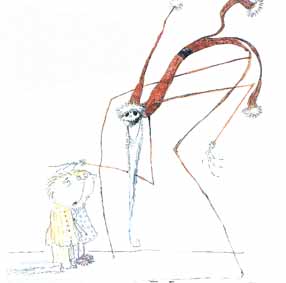 He
visited the house of Susie and Dave;
He
visited the house of Susie and Dave;
They got a Gumby and Pokey from the grave.
Then on to the home of little Jane Neeman;
She got a baby doll possessed by a demon.
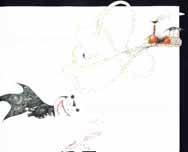 A
monstrous train with tentacle tracks,
A
monstrous train with tentacle tracks,
A ghoulish puppet wielding an ax,
A man-eating plant disguised as a wreath,
And a vampire teddy bear with very sharp teeth.
There were screams of terror, but Jack didn't hear it,
He was much too involved with his own Christmas spirit!
Jack finally looked down from his dark, starry frights
And saw the commotion, the noise, and the light.
"Why, they're celebrating, it looks like such fun!
They're thanking me for the good job that I've done."
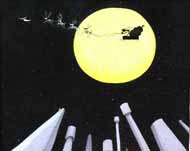 But
what he thought were fireworks meant as goodwill
But
what he thought were fireworks meant as goodwill
Were bullets and missiles intended to kill.
Then amidst the barrage of artillery fire,
Jack urged Zero to go higher and higher.
And away they all flew like the storm of a thistle,
Until they were hit by a well-guided missile.
And as they fell on the cemetery, way out of sight,
Was heard, "Merry Christmas to all, and to all a good night."
 Jack
pulled himself up on a large stone cross,
Jack
pulled himself up on a large stone cross,
And from there he reviewed his incredible loss.
"I thought I could be Santa, I had such belief. . ."
Jack was confused and filled with great grief.
Not knowing where to turn, he looked toward the sky,
They he slumped on the grave and he started to cry.
And as Zero and Jack lay crumpled on the ground,
They suddenly heard a familiar sound. . . .
 "My
dear Jack," said Santa, "I applaud your intent.
"My
dear Jack," said Santa, "I applaud your intent.
I know wreaking such havoc was not what you meant.
And so you are sad and feeling quite blue,
But taking over Christmas was the wrong thing to do.
I hope you realize Halloween's the right place for you.
There's a lot more, Jack, that I'd like to say,
But now I must hurry, for it's almost Christmas day."
 Then
he jumped in his sleigh, and with a wink of an eye,
Then
he jumped in his sleigh, and with a wink of an eye,
He said, "Merry Christmas," and he bid them good-bye.
Back home, Jack was sad, but then, like a dream,
Santa brought Christmas to the land of Halloween.
|
||||||||||||